tow Acura RL 2002 3.5 Owner's Manual
[x] Cancel search | Manufacturer: ACURA, Model Year: 2002, Model line: RL, Model: Acura RL 2002Pages: 343, PDF Size: 4.66 MB
Page 1 of 343

2002 RL Online Reference Owner's Manual
Use these links (and links throughout this manual) to navigate through this reference.
For a printed owner's manual, click on authorized manuals or go to www.helminc.com.
Contents
Owner's Identification Form
Introduction........................................................................\
............................................................................. i
A Few Words About Safety ........................................................................\
..................................................ii
Your Vehicle at a Glance........................................................................\
.......................................................2
Driver and Passenger Safety ........................................................................\
...............................................5
Proper use and care of your vehicle's seat belts, and Supplemental Restraint System.
Instruments and Controls........................................................................\
.................................................. .53
Instrument panel indica tor and gauge, and how to use dashboard and steering column controls.
Comfort and Convenience Features........................................................................\
...............................115
How to operat e the climate control system,
the audio system, and other convenience features.
Before Driving ........................................................................\
.....................................................................179
What gasoline to use, how to break-in your new vehicle, and how to load luggage and other cargo.
Driving........................................................................\
...................................................... .............................191
The proper way to start the engine, shift the transmission, and park, plus towing a trailer.
Maintenance........................................................................\
...................................................... ...................215
Th e Maintenance Schedule
shows you when you need to take your vehicle to the dealer.
Appearance Care........................................................................\
...................................................... ...........275
Tips on cleaning and protecting your vehicle. Th ings
to look for if your car ever needs body repairs.
Taking Care of the Unexpected........................................................................\
.......................................283
This section covers several prob lems motorists sometimes experience, and how to handle them.
Technical Information........................................................................\
...................................................... .311
ID numbers, dimensions, capaciti es, and technical information.
Warranty and Customer Relations (U.S. and Canada)......................................................................325
A summary of the warranties covering your new Honda, and how to contac t us.
Authorized Manuals (U.S. only)........................................................................\
.......................................329
How to order manuals and other technical literature.
Index ........................................................................\
......................................................................................... I
Service Information Summary
A summary of information you need when you pull up to the fuel pump.
Page 20 of 343
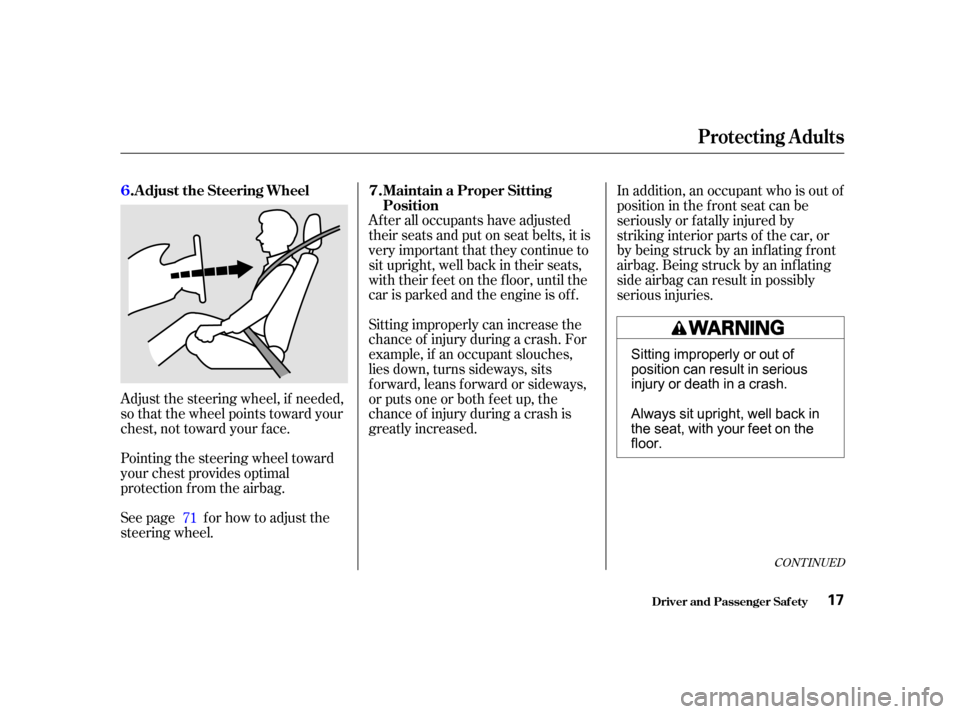
Adjust the steering wheel, if needed,
so that the wheel points toward your
chest, not toward your f ace.
See page f or how to adjust the
steering wheel. Pointing the steering wheel toward
your chest provides optimal
protection f rom the airbag.After all occupants have adjusted
their seats and put on seat belts, it is
very important that they continue to
sit upright, well back in their seats,
with their feet on the floor, until the
car is parked and the engine is of f .
Sitting improperly can increase the
chance of injury during a crash. For
example, if an occupant slouches,
lies down, turns sideways, sits
forward, leans forward or sideways,
or puts one or both f eet up, the
chance of injury during a crash is
greatly increased.
In addition, an occupant who is out of
position in the f ront seat can be
seriously or f atally injured by
striking interior parts of the car, or
by being struck by an inf lating f ront
airbag. Being struck by an inflating
side airbag can result in possibly
serious injuries.
71
CONT INUED
Adjust the Steering Wheel Maintain a Proper Sitting
Position
6.
7.
Protecting Adults
Driver and Passenger Saf ety17
Sitting improperly or out of
position can result in serious
injury or death in a crash.
Always sit upright, well back in
the seat, with your feet on the
floor.
01/09/28 19:27:27 31SZ3660_020
Page 23 of 343
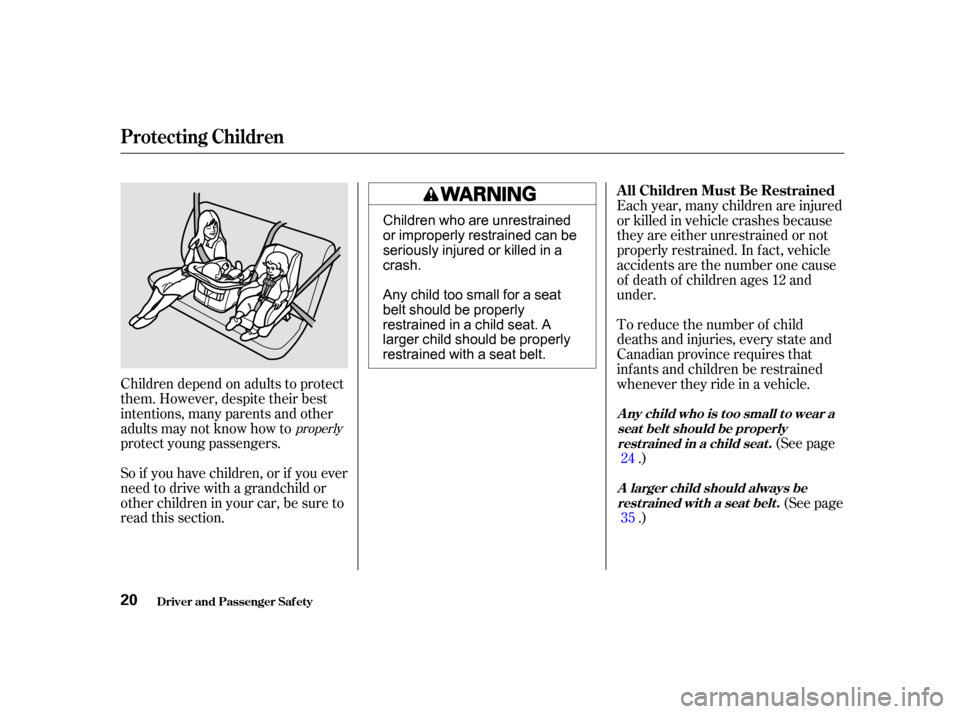
Children depend on adults to protect
them. However, despite their best
intentions, many parents and other
adults may not know how to
protect young passengers.(See page
.)
To reduce the number of child
deaths and injuries, every state and
Canadian province requires that
inf ants and children be restrained
whenever they ride in a vehicle. Each year, many children are injured
or killed in vehicle crashes because
they are either unrestrained or not
properly restrained. In f act, vehicle
accidents are the number one cause
of death of children ages 12 and
under.
(See page
.)
So if you have children, or if you ever
need to drive with a grandchild or
otherchildreninyourcar,besureto
read this section. 24
35
properly
All Children Must Be Restrained
Anychildwhoistoosmalltoweara seat belt should be properlyrest rained in a child seat .
A larger child should always berest rained wit h a seat belt .
Protecting Children
Driver and Passenger Saf ety20
Children who are unrestrained
or improperly restrained can be
seriously injured or killed in a
crash.
Any child too small for a seat
belt should be properly
restrained in a child seat. A
larger child should be properly
restrained with a seat belt.
01/09/28 19:27:55 31SZ3660_023
Page 34 of 343
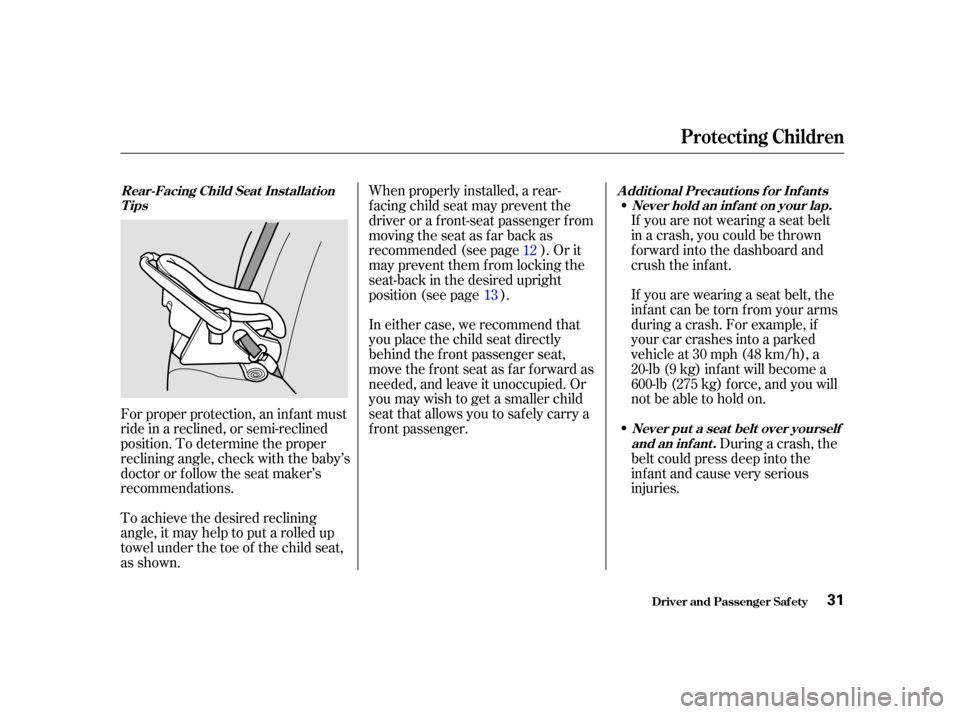
If you are not wearing a seat belt
in a crash, you could be thrown
f orward into the dashboard and
crush the inf ant.
If youarewearingaseatbelt,the
infantcanbetornfromyourarms
during a crash. For example, if
your car crashes into a parked
vehicleat30mph(48km/h),a
20-lb (9 kg) inf ant will become a
600-lb (275 kg) f orce, and you will
notbeabletoholdon.
In either case, we recommend that
you place the child seat directly
behind the f ront passenger seat,
move the front seat as far forward as
needed, and leave it unoccupied. Or
you may wish to get a smaller child
seat that allows you to safely carry a
f ront passenger. When properly installed, a rear-
f acing child seat may prevent the
driver or a f ront-seat passenger f rom
moving the seat as far back as
recommended (see page ). Or it
may prevent them f rom locking the
seat-back in the desired upright
position (see page ).
To achieve the desired reclining
angle, it may help to put a rolled up
towel under the toe of the child seat,
as shown. Forproperprotection,aninfantmust
ride in a reclined, or semi-reclined
position. To determine the proper
reclining angle, check with the baby’s
doctor or f ollow the seat maker’s
recommendations. During a crash, the
belt could press deep into the
infant and cause very serious
injuries.
12
13
A ddit ional Precaut ions f or Inf ant s Never hold an inf ant on your lap.
Rear-Facing Child Seat Inst allat ion
Tips
Never put a seat belt over yourselfand an inf ant.
Protecting Children
Driver and Passenger Saf ety31
01/09/28 19:30:00 31SZ3660_034
Page 75 of 343
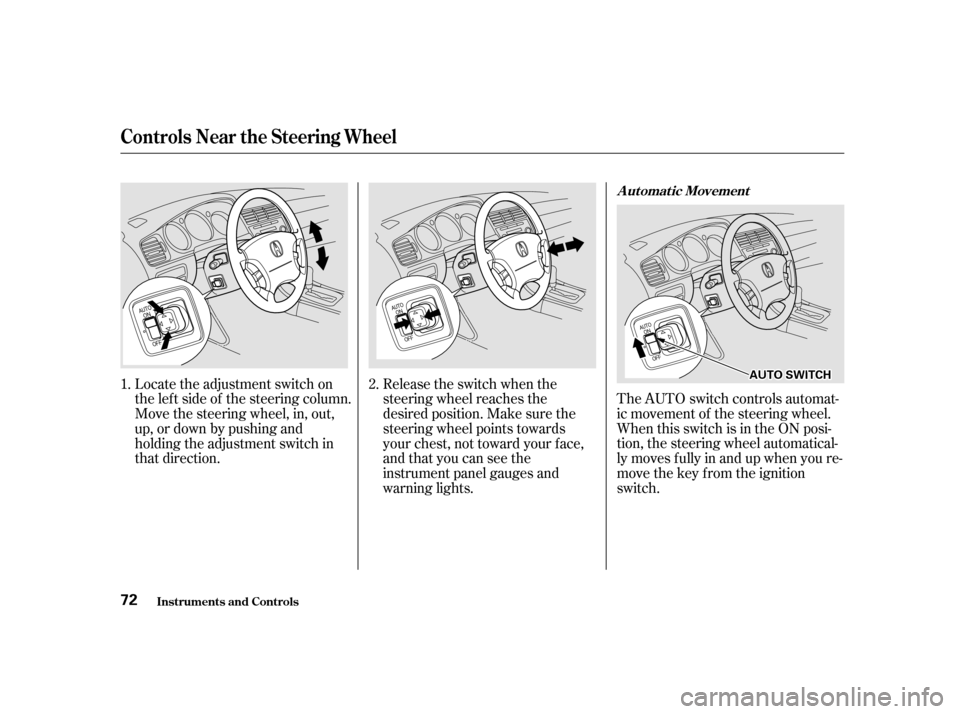
The AUTO switch controls automat-
ic movement of the steering wheel.
When this switch is in the ON posi-
tion, the steering wheel automatical-
ly moves f ully in and up when you re-
move the key from the ignition
switch.
Release the switch when the
steering wheel reaches the
desired position. Make sure the
steering wheel points towards
your chest, not toward your f ace,
andthatyoucanseethe
instrument panel gauges and
warning lights.
Locate the adjustment switch on
the lef t side of the steering column.
Move the steering wheel, in, out,
up, or down by pushing and
holding the adjustment switch in
that direction.
2.
1.
Controls Near the Steering Wheel
Inst rument s and Cont rols
Automatic Movement
72
A A U
UT TO
O S
SWWI ITT C
CH H
01/09/28 19:36:53 31SZ3660_075
Page 110 of 343
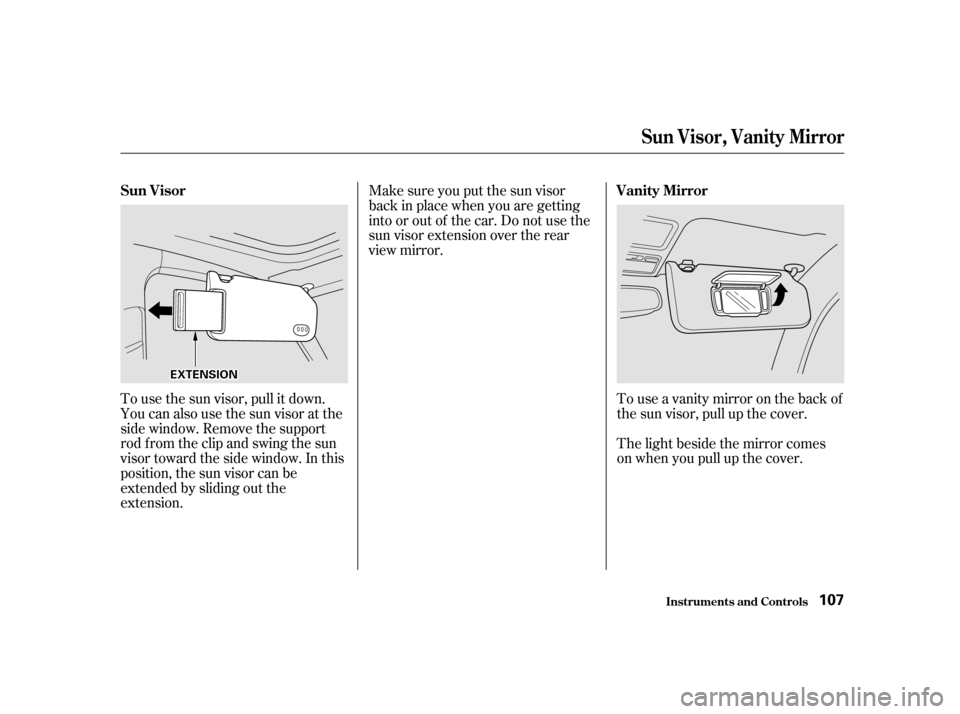
To use the sun visor, pull it down.
You can also use the sun visor at the
side window. Remove the support
rod f rom the clip and swing the sun
visor toward the side window. In this
position, the sun visor can be
extended by sliding out the
extension.Touseavanitymirroronthebackof
the sun visor, pull up the cover.
Make sure you put the sun visor
back in place when you are getting
into or out of the car. Do not use the
sun visor extension over the rear
view mirror.
The light beside the mirror comes
on when you pull up the cover.
Sun Visor
Vanity Mirror
Sun Visor, Vanit y Mirror
Inst rument s and Cont rols107
E EX
X T
TE
EN
NS SIIOON N
01/09/28 19:42:35 31SZ3660_110
Page 184 of 343
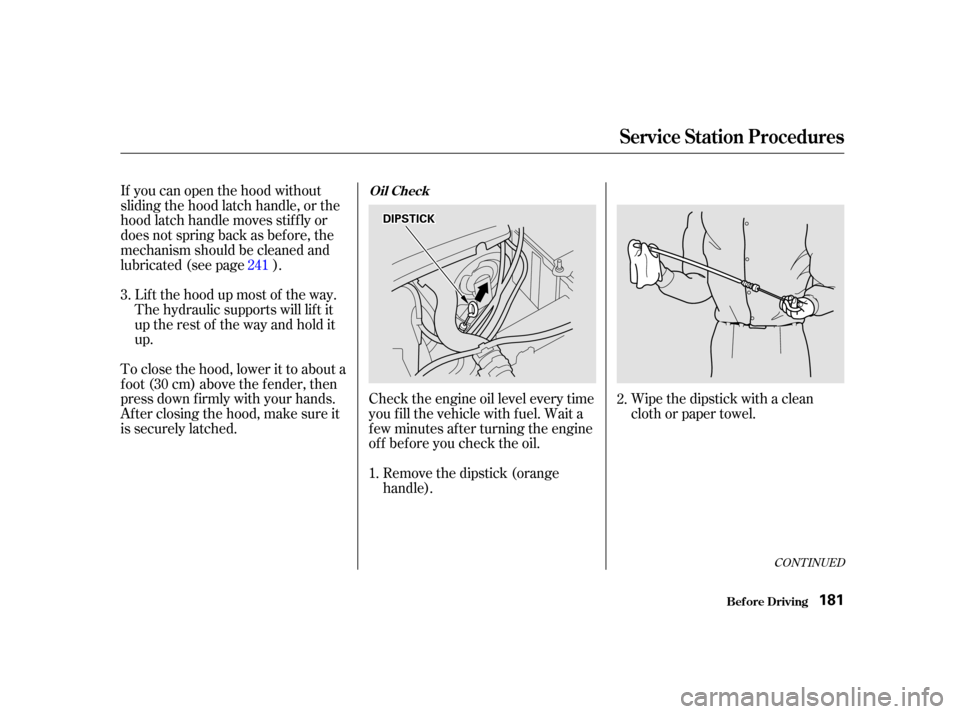
CONT INUED
Wipe the dipstick with a clean
cloth or paper towel.
Check the engine oil level every time
you f ill the vehicle with f uel. Wait a
f ew minutes af ter turning the engine
of f bef ore you check the oil.
Remove the dipstick (orange
handle).
If you can open the hood without
sliding the hood latch handle, or the
hood latch handle moves stif f ly or
does not spring back as bef ore, the
mechanism should be cleaned and
lubricated (see page ).
Lif t the hood up most of the way.
The hydraulic supports will lif t it
uptherestof thewayandholdit
up.
To close the hood, lower it to about a
f oot (30 cm) above the f ender, then
press down f irmly with your hands.
Afterclosingthehood,makesureit
is securely latched. 2.
1.
3.
241
Service Station Procedures
Bef ore Driving
Oil Check
181
D D
I
IPP S
ST TI
ICCK K
01/09/28 19:55:12 31SZ3660_184
Page 189 of 343

The glove box, and the pockets in
the front doors and seat-back, are
designed f or small, lightweight items.
The trunk is intended f or larger,
heavier items. Your car has several convenient
storage areas so you can stow cargo
saf ely.
However, carrying too much cargo,
or improperly storing it, can af f ect
your car’s handling, stability, and
operation and make it unsafe. Before
carrying any type of cargo, be sure to
read the f ollowing pages.
Carrying Cargo
Bef ore Driving186
F FRRO ON NTT D
DO
OO ORR P
PO
OC CKKEET
T
C
CO ON NSSOOL LEE C
COOM M P
PA
A R
RTTM
M E
EN
NT T
G
GLLOOV VE
E B
BOOX X
S
SE EA
A T
T-
-B
BA A C
CKK P
PO
OC CKKEET
T
T
T R
RU UN NKK
01/09/28 19:56:02 31SZ3660_189
Page 190 of 343

Store or secure all items that could
be thrown around and hurt
someone during a crash.
Besureitemsplacedonthefloor
behind the f ront seats cannot roll
under the seats and interf ere with
the driver’s ability to operate the
pedals, or with the proper
operation of the seats.
Keep the glove box closed while
driving. If the lid is open, a
passenger could injure their knees
during a crash or sudden stop.
The maximum load for your car is
850 lbs (395 kg).
Do not put any items on top of the
rear shelf . They can block your
viewandbethrownaroundthecar
during a crash.
The f inal number is the total weight
of cargo you can carry. Subtract the total f rom 850 lbs
(395 kg). If you are towing a trailer, add the
tongue weight to the number
above. Add up the weight of all occupants.
To f igure out how much cargo you
can carry: This f igure includes the total weight
of all occupants, cargo, accessories,
and the tongue weight if you are
towing a trailer. Carrying Items in the Passenger
Compartment
Load Limit
Carrying Cargo
Bef ore Driving187
Overloading or improper
loading can affect handling and
stability and cause a crash in
which you can be hurt or killed.
Follow all load limits and other
loading guidelines in this
manual.
01/09/28 19:56:15 31SZ3660_190
Page 192 of 343

This section gives you tips on
starting the engine under various
conditions, and how to operate the
automatic transmission. It also
includes important inf ormation on
parking your car, the braking system,
the Vehicle Stability Assist System,
and f acts you need if you are
planning to tow a trailer.........................
Preparing to Drive .190
.......................
Starting the Engine .191
Starting in Cold Weather ....................
at High Altitude .191
..............
Automatic Transmission .192
.
Shif t Lever Position Indicator .192
................
Shif t Lever Positions .192
..............
Engine Speed Limiter .194
....................
Shif t Lock Release .195
...........................................
Parking .196
.....................
The Braking System .197
.............
Brake Wear Indicators .197
...............
Brake System Design .198
.......................
Anti-lock Brakes .198
Important Saf ety .........................
Reminders .199
........................
ABS Indicator .199
...
Vehicle Stability Assist System .201
...............
Driving in Bad Weather .204
...........................
Towing a Trailer .206
Driving
Driving189
01/09/28 19:56:26 31SZ3660_192